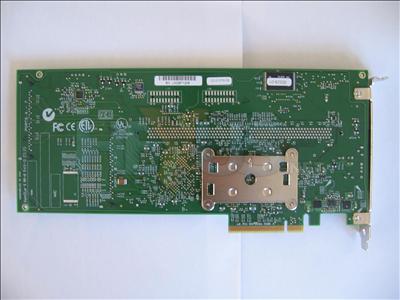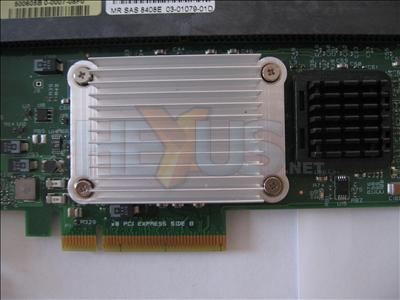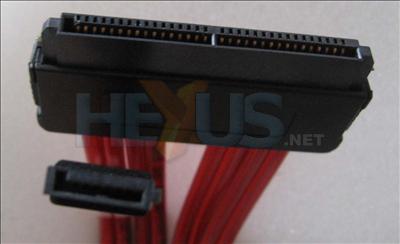LSI Logic MegaRAID SAS 8408E
On to the RAID card, then. Here we have LSI's MegaRAID 8408E.
She's a big one, isn't she? We'll wave goodbye now to all the people who were hoping for something low profile.
Under the unpainted heatsink is, we're assuming, the Intel IOP333 CPU, charged with array management and the XOR computations required for data parity creation. The black heatsink most likely hides the SAS/SATA PHY for the two four-port SAS connectors. The connectors take up a heck of a lot of space on the board because of their width and the type of cable that connects to them (which you'll see shortly.)
The RAM module is a 256MiB DIMM populated with DDR2-400 chips. It appears some versions of this RAID card come with a battery backup module attached to the DIMM, to keep the cache alive during a power loss. We didn't have one on the test example, though.
At the rear, all there is to see is the main heatsink bracket and towards the top, covered by a sticker, is a flash ROM for storing the card's firmware.
Attention, class, it's time for a quick recap lesson on PCI-Express. A single lane of PCIe operates in full-duplex mode with a data rate of 2.5Gbps. That's 2.5Gbps in both directions, simultaneously. PCIe uses 8B/10B encoding, which means it takes 8 bits of data and encodes it into a 10 bit word, so only 80% of the available bandwidth is actually used to transmit data (which will itself be wrapped in other layers of protocols). The end result is 250MiB/s per lane in each direction.
The above connector is an 8-lane connector, so a quick bit of maths leads us to a theoretical transfer rate of 2GiB/s in both directions. Old school 33Mhz, 32-bit PCI can manage 133MiB/s. Reckon 8x PCIe will be enough for this SAS RAID card? Yeah, we do too.
Now, we mentioned cables earlier and it's important we explain them in a little more detail. SAS, or Serial Attached SCSI, is backwards compatible with SATA (although we'd prefer the term 'sideways compatible' given that SAS and SATA seem able to coexist). SAS drives use a much smaller SATA style connection compared to SCSI drives of yore. Further, SAS isn't designed just for linking up card and drive. Cables can be hooked up to expanders and enclosures too, leading to a 128 device limit.
Unfortunately, the cable type differs depending on what you're connecting up to. We were hooking straight up to SATA drives, which meant we needed a crossover cable, not a straight through one. This one had us baffled for a while, new as we are to SAS, but props to the support folks at Boston who soon had us back on track.
See how deep the moulding on the connector is? That's why so much space is needed on the RAID card. The fat connector leads to four of the SATA connections most of you will be more familiar with.
Physically, the card smacks of server storage, as you'd expect. It would have been nice to see some extra support for the card, given its length. For example, graphics cards use the catch of a PEG slot, where it's available.














